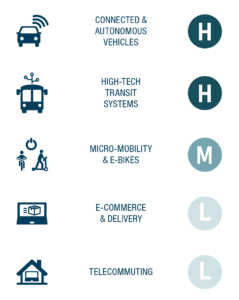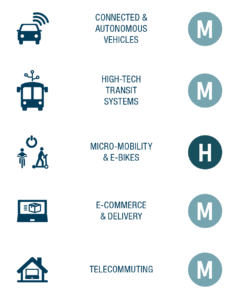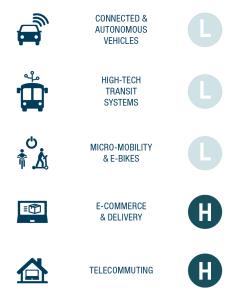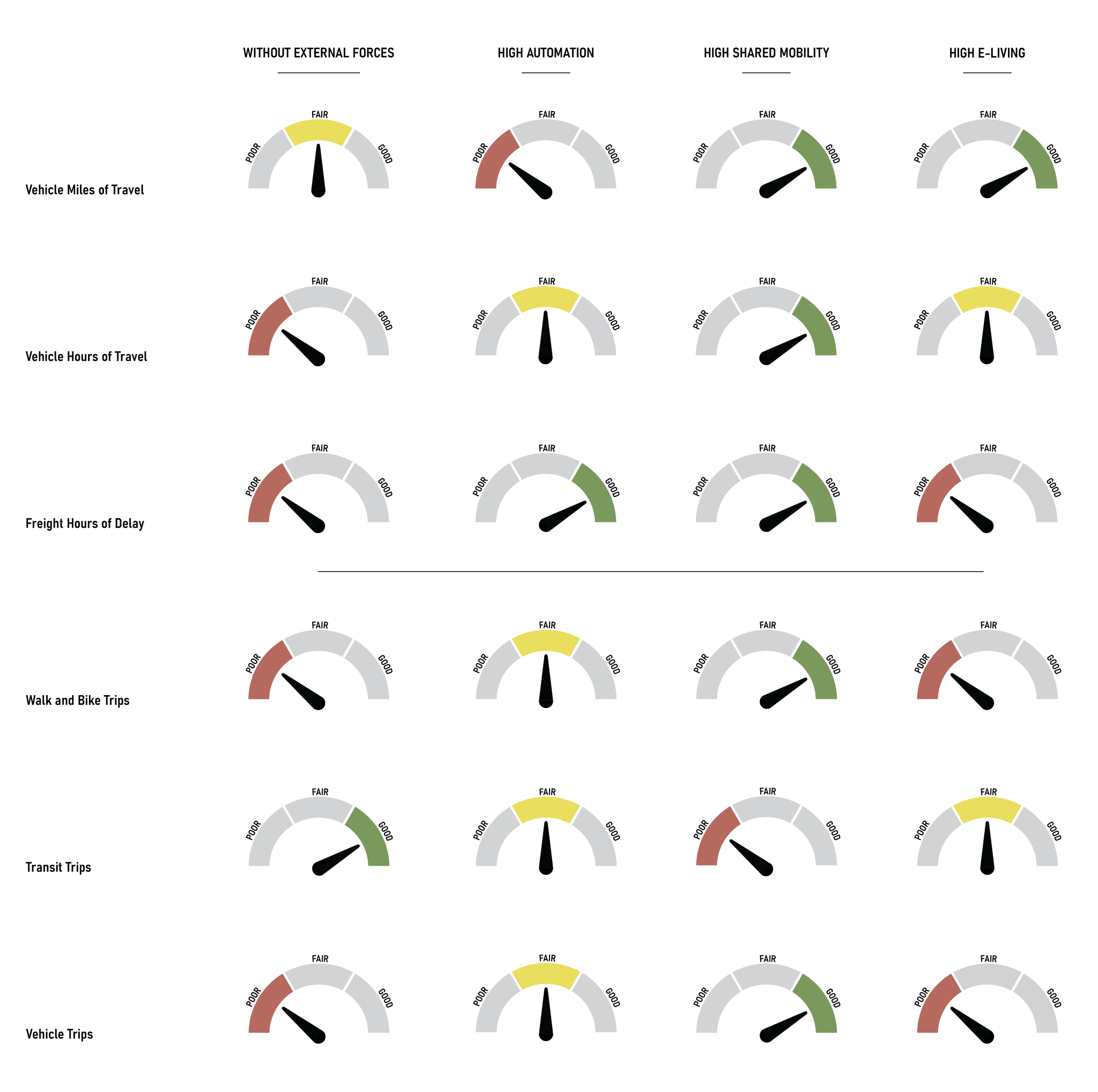
External forces are transportation technologies and shifts in market and consumer demand that may impact transportation, land use, and economic development decisions. To prepare the Region and be more resilient to uncertain future changes, WFRC identified 11 initial external forces. These 11 external forces were refined to focus on six forces within three categories based on feedback from peer groups: Automation, Shared Mobility, and E-living. The categories were developed into scenarios to explore the impact of high levels of implementation of each category. For example: how might transportation systems change in a world dominated by automated transit? How might micro-mobility and on-demand transportation services be impacted by high adoption rates of e-commerce and telecommuting? These are the kinds of questions that 2023-2050 Regional Transportation Plan explores.
The external forces that WFRC considered for the 2023-2050 RTP update are connected and autonomous vehicles, high tech transit systems, micro-mobility and e-bikes, on-demand travel and sharing services, e-commerce and delivery, and telecommuting. COVID-19 recovery was also considered as an overarching external force.
The WFRC also created a list of policies aimed toward resiliency that could help the Region adapt and respond to the external forces identified. These policies are mobile app development, congestion pricing, managed lanes, fare-free transit, curbside management, subsidized e-bike purchase, parking modernization, local street design modifications, road usage charge, street connectivity, and transit prioritization.
Autonomous vehicles (AVs) are vehicles that are capable of driving without human intervention (also called self-driving or driverless vehicles). A connected vehicle (CV) is one that communicates with other vehicles (V2V), infrastructure (V2I), and other road users (V2X) via wireless technology.
By eliminating the high time costs of transportation and making travel more convenient, CAV has the potential to increase vehicle travel and increase the amount of time people are willing to commute. These factors could lead to more congestion on roadways.
High-tech transit systems utilize technology within their fleet. Often utilizing the Intelligent Transportation System (ITS) to become more efficient through Transit Signal Priority (TSP), Traffic Signal Coordination (TSC), and other technologies.
These advances in transit technology improve the reliability of transit systems which can lower wait times and overall transit times. Additionally, high-tech transit systems can be integrated with AV technology to optimize transit and provide a greater degree of first/last-mile connections.
Micro-mobility refers to the use of lightweight devices that are typically used for shorter-distance transport. These can include electric assisted bicycles (e-bikes), electric scooters (e-scooters), and other mobility devices that have improved electric motor technology.
The use of micro-mobility and e-bikes decreases parking demand in dense urban cores and may replace some vehicle trips. However, investments and maintenance of infrastructure and proper curb management are required for successful adoption.
The use of a mobile application that enables users to call/secure individual and shared transportation services.
TNC services such as Uber and Lyft impact transportation choices and in some cases may decrease public transit ridership.
E-commerce and delivery refer to a series of changes that are occurring in the way people purchase goods and how those goods are delivered. These include, but are not limited to, internet shopping, food delivery, truck automation and platooning, and last-mile delivery logistics, including the use of drones.
Connected and autonomous freight trucks provide opportunities to reduce fuel consumption and decrease delivery times while increased demand for warehousing space is placing products closer to their destinations.
A work arrangement in which an employee works outside the office, often working from home or a remote location. Telecommuting reduces roadway congestion during peak travel times by eliminating the need for employees to commute into an office. However, this work arrangement may make living in more remote locations more desirable which in turn may increase weekly VMT.

High Automation Scenario
This scenario explores the impacts of robust adoption of connected and autonomous vehicles and high-tech transit systems. It assumes high levels of implementation of AV/CAV and high-tech transit, low levels of implementation of telecommuting and e-commerce, and medium levels of implementation of micro-mobility options.

High Shared Mobility Scenario
This scenario imagines the impacts of high use of shared mobility options such as micromobility and on demand and ridesharing services. It assumes high levels of implementation of micro-mobility such as e-bikes, and medium levels of implementation of all other forces.

High E-Living Scenario
This scenario investigates the impacts of lifestyle shifts that favor telecommuting and e-commerce and delivery. It assumes high levels of implementation of telecommuting and e-commerce and low levels of implementation of all other forces.
With ranges of implementation determined, WFRC determined how to reflect the scenarios within the travel demand model. Often, the model did not have a specific functionality to reflect the differing impact of the external forces. For instance, there is no specific input for e-commerce and delivery. However, several “dials” within the model can be adjusted to reflect the totality of e-commerce and delivery effects. A memo is forthcoming documenting source material and explaining assumptions and “dials” adjusted to reflect the external forces impact on the travel demand model.

For additional information regarding the RTP, please contact Jory Johner.

